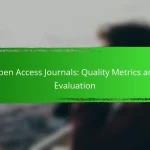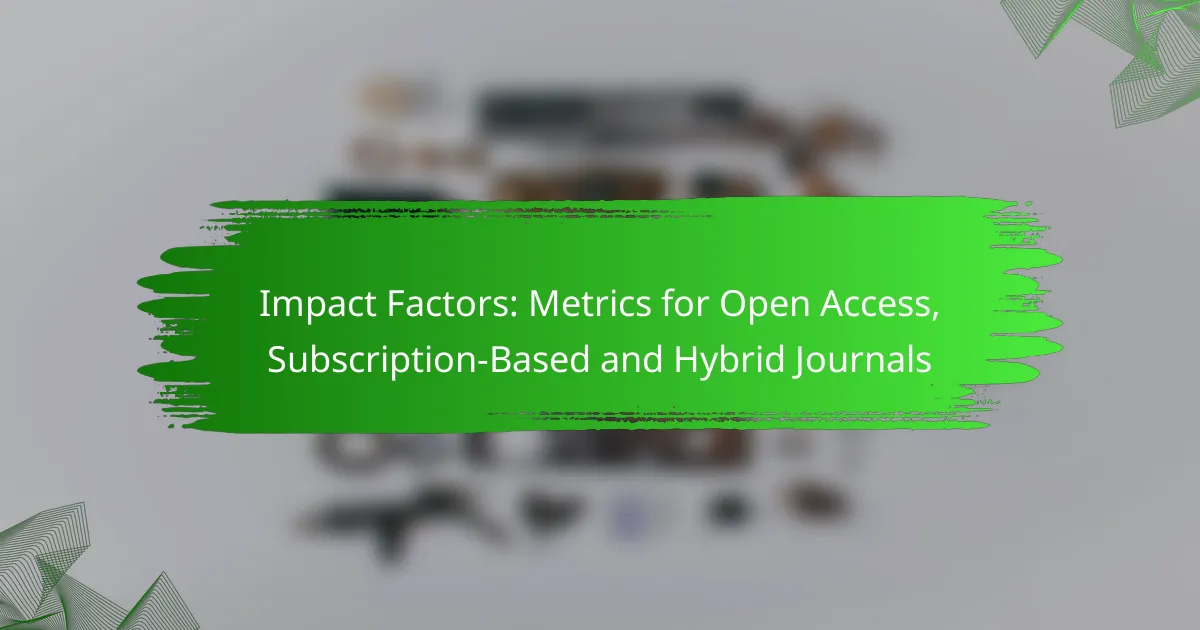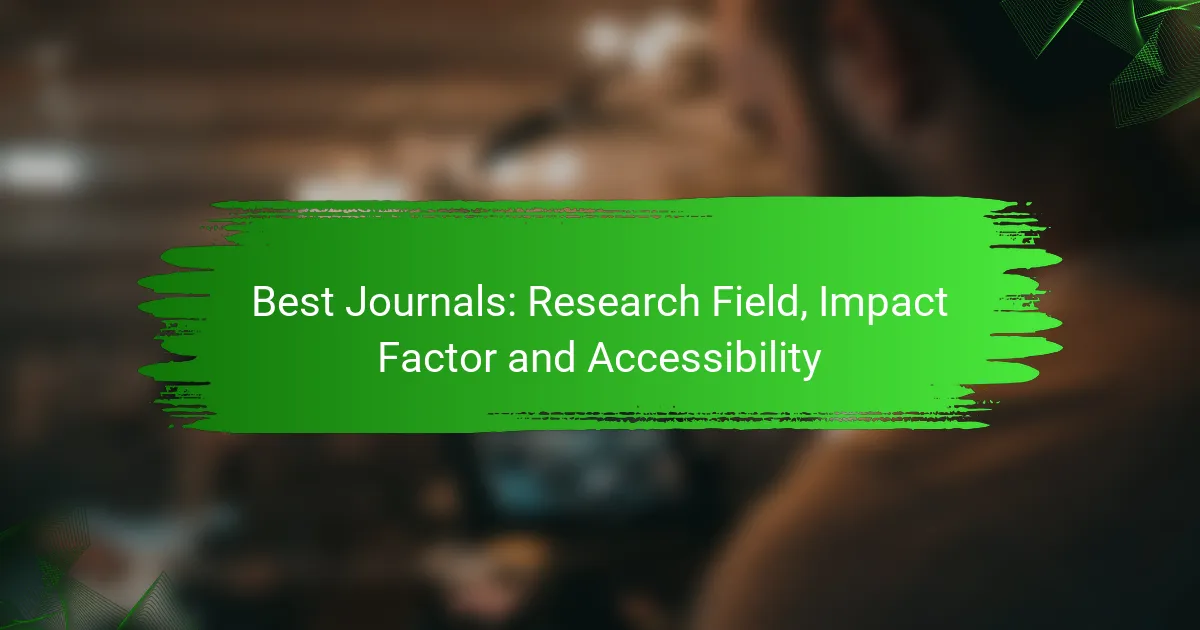Impact factors play a crucial role in the evaluation of academic journals, with notable differences among open access, subscription-based, and hybrid models. These metrics, such as Journal Citation Reports and Scimago Journal Rank, influence the visibility and accessibility of research, ultimately guiding authors in their publishing decisions and affecting citation rates.
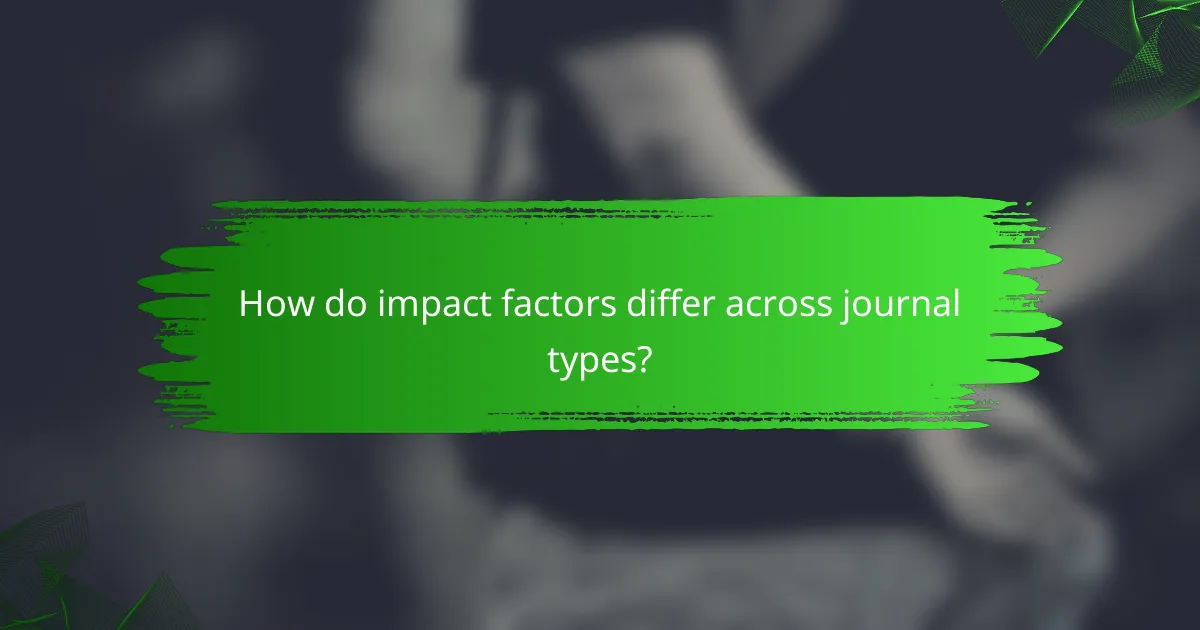
How do impact factors differ across journal types?
Impact factors vary significantly among open access, subscription-based, and hybrid journals, influencing how research is disseminated and evaluated. Each type has its own metrics and considerations that can affect visibility, accessibility, and citation rates.
Open Access journals
Open access journals typically have higher visibility since they allow unrestricted access to their content. This can lead to increased citation rates, as more researchers can read and reference the work without paywalls. However, the impact factors for these journals can vary widely, often depending on the journal’s reputation and indexing in major databases.
Many open access journals charge article processing fees (APCs), which can range from a few hundred to several thousand USD. Authors should consider the journal’s impact factor and its indexing status when selecting a venue for publication.
Subscription-based journals
Subscription-based journals often have established impact factors that reflect their long-standing presence in the academic community. These journals may have rigorous peer review processes and high standards for publication, which can enhance their credibility. However, access is limited to subscribers, which may restrict readership and citation opportunities.
Impact factors for subscription journals can vary, but many are well-documented in databases like Journal Citation Reports. Authors should weigh the benefits of a higher impact factor against the limitations of restricted access.
Hybrid journals
Hybrid journals combine elements of both open access and subscription models, allowing authors to choose between traditional subscription access or paying an APC for open access. This flexibility can attract a broader audience while still maintaining a subscription revenue model. The impact factors for hybrid journals can be competitive, often reflecting the quality of their open access articles.
When considering hybrid journals, authors should evaluate the potential reach of their work based on the chosen access model and the journal’s overall impact factor. Understanding the audience and citation patterns can help in making an informed decision.
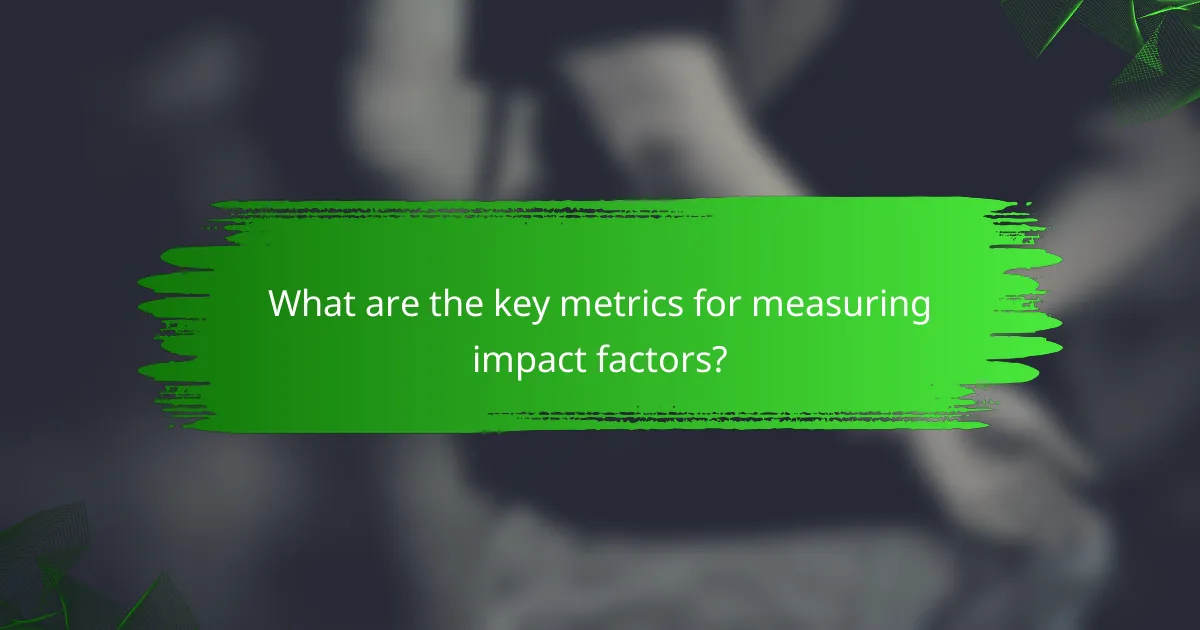
What are the key metrics for measuring impact factors?
The key metrics for measuring impact factors include Journal Citation Reports, Scimago Journal Rank, and Eigenfactor Score. These metrics help assess the influence and reach of academic journals, guiding researchers in selecting where to publish their work.
Journal Citation Reports
Journal Citation Reports (JCR) is a widely recognized tool that provides data on journal impact factors based on citation analysis. It calculates the average number of citations received in a particular year by articles published in the journal during the previous two years.
When evaluating a journal using JCR, consider the impact factor range, which can vary significantly across disciplines. A higher impact factor often indicates a more influential journal, but it’s essential to compare journals within the same field for a fair assessment.
Scimago Journal Rank
The Scimago Journal Rank (SJR) is another important metric that measures the scientific influence of journals based on citation data. It accounts for both the number of citations received and the prestige of the journals where such citations come from.
SJR values are calculated using a three-year period, making it a useful tool for understanding long-term trends in journal performance. Journals with higher SJR scores are typically more respected, but researchers should still consider the specific context of their field when interpreting these scores.
Eigenfactor Score
The Eigenfactor Score evaluates the overall influence of a journal by considering the number of citations received, adjusting for the quality of the citing journals. This metric reflects the journal’s importance in the broader academic landscape.
Eigenfactor scores are calculated over a five-year period, providing a more comprehensive view of a journal’s impact. A journal with a high Eigenfactor score is often a strong choice for researchers looking to maximize the visibility of their work, but it’s crucial to align this choice with specific research goals and fields of study.

How do impact factors influence research visibility in the UK?
Impact factors significantly affect research visibility in the UK by determining how often articles are cited and accessed. Journals with higher impact factors tend to attract more attention from researchers, leading to increased dissemination of findings.
Increased accessibility
Open access journals often have higher impact factors due to their unrestricted accessibility. Researchers and the public can easily access these articles without subscription fees, which enhances visibility and engagement.
In the UK, many institutions support open access publishing, aligning with funding body mandates. This trend encourages researchers to publish in open access venues, further increasing the visibility of their work.
Higher citation rates
Higher impact factors correlate with increased citation rates, as articles in these journals are more frequently referenced in subsequent research. This phenomenon occurs because well-regarded journals attract quality submissions and a broader audience.
For UK researchers, publishing in high-impact journals can lead to greater recognition and influence within their fields. It is advisable to consider the impact factor of a journal when selecting where to submit work, as this can enhance the likelihood of citations and collaborations.

What are the challenges in comparing impact factors?
Comparing impact factors across different journal types—open access, subscription-based, and hybrid—poses several challenges due to variations in metrics, disciplinary norms, and publication practices. These differences can lead to misleading conclusions about a journal’s influence or quality.
Variability in metrics
Impact factors can vary significantly depending on the metrics used to calculate them. For instance, some journals may rely on citation counts, while others might incorporate article views or downloads. This variability can create confusion when trying to assess the relative impact of journals across different fields.
Additionally, the time frame for measuring citations can differ. Some journals calculate their impact factors annually, while others may use a multi-year average, affecting the perceived stability of their metrics. Researchers should be cautious and consider the specific metrics employed when comparing journals.
Disciplinary differences
Different academic disciplines have unique publication and citation practices, which can skew impact factor comparisons. For example, fields like medicine may have higher citation rates due to the rapid pace of research, while humanities disciplines often see lower citation counts but may still produce influential work.
Moreover, the types of articles published can vary widely. Some journals might focus on original research, while others publish reviews or theoretical papers, leading to inherent differences in citation patterns. Understanding these disciplinary contexts is crucial for accurately interpreting impact factors.
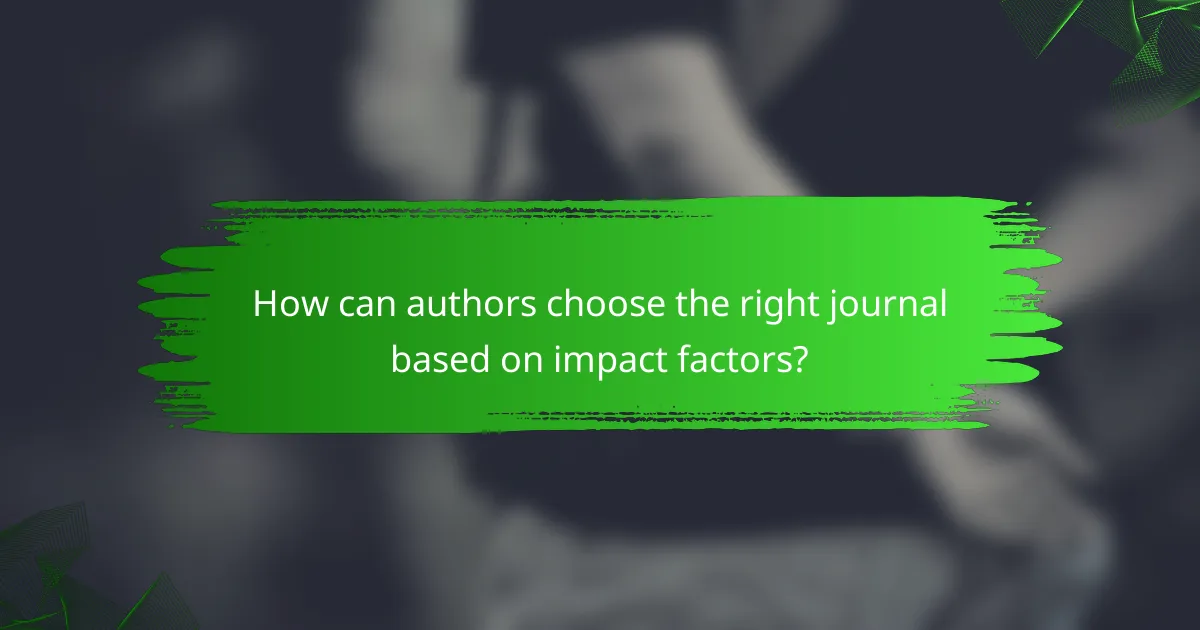
How can authors choose the right journal based on impact factors?
Authors can choose the right journal by considering impact factors, which indicate the average number of citations to recent articles published in that journal. Evaluating these metrics helps authors align their work with the appropriate audience and enhances visibility in their field.
Assessing target audience
Understanding the target audience is crucial when selecting a journal. Authors should consider who will read their work and whether the journal caters to that demographic. For instance, a journal focused on clinical research may attract healthcare professionals, while one centered on theoretical studies might appeal to academics.
To assess the target audience, authors can review the journal’s scope, the types of articles published, and the affiliations of its contributors. Checking the readership demographics or subscriber information can also provide insights into the audience’s characteristics.
Evaluating journal reputation
Evaluating a journal’s reputation involves looking at its impact factor, editorial board, and indexing in major databases. A higher impact factor generally indicates a more respected journal, but authors should also consider other qualitative factors such as peer review rigor and editorial transparency.
Authors can compare journals by examining lists of reputable journals in their field, such as those indexed in Scopus or Web of Science. Additionally, seeking recommendations from colleagues or mentors can help identify well-regarded journals that align with their research focus.

What role do publisher practices play in impact factors?
Publisher practices significantly influence impact factors by determining how research is disseminated and accessed. These practices can affect citation rates, visibility, and ultimately the perceived value of the research published in their journals.
Open Access policies
Open Access (OA) policies allow researchers to publish their work freely available to the public, which can enhance visibility and citation rates. Journals with robust OA practices often experience higher impact factors due to increased accessibility, as more readers can engage with the content without paywalls.
However, OA journals may require authors to pay article processing charges (APCs), which can range from a few hundred to several thousand USD. Researchers should weigh the benefits of increased exposure against the potential financial burden of publishing in OA journals.
Subscription pricing models
Subscription-based journals typically charge institutions or individuals for access to their content, which can limit readership and citations. These models can create barriers for researchers and practitioners who may not have institutional access, potentially lowering the impact factor of the journal.
Some subscription journals are adopting hybrid models, allowing authors to pay for OA options within a traditionally subscription-based framework. This approach can help balance accessibility with the financial sustainability of the journal, but authors should consider the additional costs involved when choosing this route.

How do emerging trends affect impact factors?
Emerging trends significantly influence impact factors by reshaping how research is disseminated and evaluated. The rise of preprint servers and the shift towards open science are key developments that alter traditional metrics and perceptions of journal quality.
Rise of preprint servers
The rise of preprint servers allows researchers to share their findings quickly before formal peer review, which can enhance visibility and citation potential. This rapid dissemination can lead to increased impact factors for journals that embrace preprints, as they may attract more citations from the early availability of research.
However, the challenge lies in the quality control of preprints, as not all submissions undergo rigorous peer review. Journals must balance the benefits of increased exposure with the risk of publishing unverified findings, which could affect their credibility and impact factor.
Shift towards open science
The shift towards open science promotes transparency and accessibility in research, which can positively impact journal metrics. Open access journals often see higher citation rates due to the unrestricted availability of their articles, making them more appealing to researchers and institutions.
Nonetheless, the transition to open science can come with financial implications, as many open access models require authors to pay article processing charges (APCs). Researchers should consider the cost-benefit ratio of publishing in open access versus subscription-based journals, especially when evaluating potential impact factors.

What are future directions for impact factor metrics?
Future directions for impact factor metrics focus on enhancing transparency, inclusivity, and relevance in measuring research quality. As the landscape of academic publishing evolves, metrics will likely adapt to better reflect the diverse contributions of open access, subscription-based, and hybrid journals.
Increased Transparency in Metrics
Future impact factor metrics are expected to prioritize transparency, allowing researchers to understand how scores are calculated. This could involve clearer methodologies and the inclusion of diverse data sources, such as social media mentions and altmetrics, which capture broader engagement beyond traditional citations.
For example, journals may publish their calculation methods openly, enabling researchers to assess the reliability of the metrics. This shift could help mitigate biases inherent in current systems, fostering a more equitable evaluation of scholarly work.
Emphasis on Diverse Metrics
There is a growing recognition that a single impact factor does not adequately represent the quality of research. Future directions may include the development of composite metrics that incorporate various indicators, such as citation counts, download statistics, and engagement metrics.
Journals might adopt a multi-faceted approach, combining traditional impact factors with newer metrics like article-level metrics or community engagement scores. This could provide a more holistic view of a journal’s influence and the impact of individual articles.
Adaptation to Open Access Models
As open access publishing gains traction, impact factor metrics will likely evolve to accommodate this model. This may involve adjusting how citations are counted for open access articles, recognizing their broader accessibility and potential for higher visibility.
For instance, journals could implement metrics that specifically track the reach and engagement of open access publications, distinguishing them from subscription-based articles. This adaptation would help ensure that the contributions of open access research are fairly evaluated.
Integration of Altmetrics
Future impact factor metrics may increasingly incorporate altmetrics, which measure the online attention and engagement received by research outputs. This could include social media shares, blog mentions, and other digital interactions that reflect a work’s influence beyond academic citations.
By integrating altmetrics, journals can provide a more comprehensive view of research impact, appealing to a broader audience and recognizing diverse forms of scholarly communication. This shift would align with the changing nature of research dissemination in the digital age.


